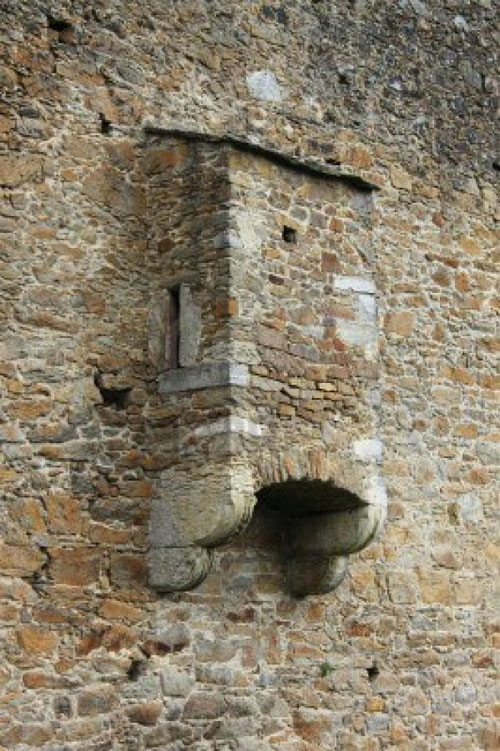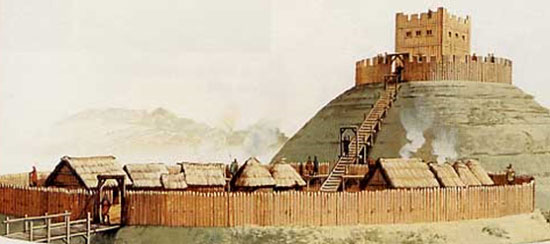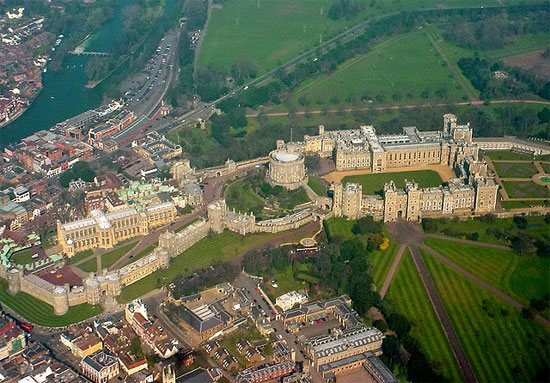Interesting things about ancient castles in Europe
Today the castles in Europe are only historical relics, serving tourists and not being human residences. However, once there was a time, castles were the 'number 1' residence of the aristocracy, helping them protect their property and show their status in society. Inside those old castles is the medieval building structure and life that can make readers feel really interesting.
Personal toilet seat

The medieval castle has no bathroom as comfortable as we do today. During construction, engineers designed a number of small structures called garder s, which is a sewer that people can use to toilet and waste will flow through the wall into the moat. But that's just an inconvenience. The bathroom is always cold and windy because every drain leads directly to the outside.
Construction materials

The first castles in Europe were built of wood
When the Norman arrived in England nearly a thousand years ago, they built wooden castles in the 'motte-and-bailey' way , that is, building castles on natural or artificial high ground, surrounded by a large yard with shielding walls and a protective moat. This makes people and enemies in a lower position and must "waste time" when climbing the slope to reach the castle. Although taking advantage of the high ground to create a good defensive position, but with the material of the shielding wall made of wood, it makes them easily burned and in the long run will be easily damaged by moisture. musty.
The oldest castle is still inhabited

The more than 900-year-old Windsor Castle is located in the Berkshire town of Windsor, less than an hour's drive from central London, one of the three official residences of the Royal Family along with Buckingham Palace in London and Holyrood in Edinburgh. Windsor was originally a motte-and-bailey wooden castle built by King William I in the middle of the 11th century after the Norman occupied British Island. Later the castle was expanded many times and re-renovated with stone and built a few other highlights such as the wall of fortified walls and round towers by King Henry II. With a floor area of 44,965m 2 , Windsor is the largest and oldest castle in the world today.
Purpose of construction

Looking at the general characteristics of the design of the castle, we can immediately see what their purpose is for. With the surrounding moat system, tunnels, watchtowers, killing pits, apricot holes . of course they were built with the aim of preventing the enemy from approaching the castle. The killing pits are holes designed above the soldiers' holes that can throw stones, shoot arrows or pour oil and boiling water into the enemy. Apricot holes are carved on the walls and towers to shoot arrows or bullets while hiding the location of weapons. In addition, when attacked, soldiers also pour boiling oil on the moat around the castle to create a sea of fire to stop the enemy.'Successful' for such carefully guarded castles is always accompanied by relatively large human losses.
Stairs

Stairs in medieval castles always have a clockwise spiral. The meaning of this design comes from a very realistic purpose. When the enemy encircles the castle they have to climb the bridge to reach the inside of the castle, but this will make it difficult for them to swing the sword because most people are right-handed. On the other hand, people who live in castles when going downstairs will have an advantage when holding weapons in the right hand.
Number of castles

According to statistics of the book Castellarium Anglicanum, there were 1500 castles existed in the territory of England and Wales. However, many of these castles have been destroyed and we can no longer see them. Over 800 castles have traces left over and more than 300 castles are still standing and almost still intact in structure.
"Comfort" level

When we think about the castle, we often think of the magnificent lavish rooms, but the truth is quite the opposite. Medieval castles are lit very little, mainly thanks to the sunlight shining through the windows so they are quite wet and very mysterious due to poor air circulation. Besides, the castle is built with the main purpose of defense, so creating comfortable living conditions is secondary. However, at a later stage, the lords decorated with curtains and glass changed colors into windows and lavish furniture to make their castle more magnificent, as well as to reflect his wealth and authority.
Partying is the main entertainment hobby

Life in medieval castles is really boring. If there are some activities only for men, such as hunting or combat training, outside the castle is even more dull. People often play chess to kill time so the number 1 way to relieve boredom is to organize food. At such parties, there are a lot of dishes and wine that are displayed, and there are also dancing and singing items that make the atmosphere become more bustling.
The life of the servant

The servant in the castle, though being treated badly, is no different from a slave, but in terms of living conditions, they have a relatively good life compared to other people. They slept in separate rooms with private fireplaces while the rest of the castle was very wet and cold. If they slept on the floor, they would be granted the blanket by the lord. If compared to other lowly people who sleep in watchtowers and only have bed linen for heating, people's lives are worth their dream.
Water well - Achilles heel

If the citadel is built so solidly to attack, the enemy needs to find a weakness. The Achilles heel of any fortified castle is a well. The well is the main source of water for all residents inside the castle. If the enemy tainted the water source or the warlords did not care for the unfortunate source of water to be exhausted, the whole elaborately designed structure of the whole castle would become a junk. At that time it was the best time to attack the castle.
- 10 interesting things about life you may not know
- Kingdom of castles
- Discover medieval castle
- 10 interesting things about nature you may not know
- Going from one surprise to the other is different from the interesting things about all things
- Super interesting things about math you will definitely fall back
- The secret to creating sand castles
- 12 horrible things about China you may not know
- Animal World - Interesting things you don't know
- 10 interesting things about cats
- 10 interesting things about the Internet that you don't know
- Revealing an interesting secret about coffee makes you not surprised
 'Fine laughs' - Scary and painful torture in ancient times
'Fine laughs' - Scary and painful torture in ancient times The sequence of numbers 142857 of the Egyptian pyramids is known as the strangest number in the world - Why?
The sequence of numbers 142857 of the Egyptian pyramids is known as the strangest number in the world - Why? History of the iron
History of the iron What is alum?
What is alum?